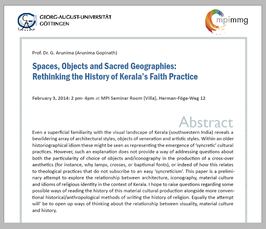"Spaces, Objects and Sacred Geographies: Rethinking the History of Kerala’s Faith Practice"
- Datum: 03.02.2014
- Uhrzeit: 14:00 - 16:00
- Vortragende: G. Arunima (Arunima Gopinath) (Jawaharlal Nehru University, New Delhi)
- G. Arunima (Arunima Gopinath) is Associate Professor of Women’s Studies at JNU, Delhi and currently a Fellow at the Internationales Kolleg Morphomata, University of Kölln. She is the author of ‘There Comes Papa: Colonialism and the Transformation of Matriliny in Kerala, Malabar c. 1850-1940 (2003) and numerous articles and book chapters. She is currently completing a monograph entitled Novel Images: Aesthetics, Culture, and Modernity in Colonial South India, Kerala 1870-1940. Professor Gopinath’s research projects include: “Sacred Geographies, Hybrid Iconographies: Faith Practices and Idioms of Malayali Religious Iconography” and “Gender, Photography and Visual Practices in Contemporary India.”
- Ort: MPI-MMG, Hermann-Föge-Weg 12, Göttingen
- Raum: Conference Room

For more details please contact vdvoffice(at)mmg.mpg.de.
Even a superficial familiarity with the visual landscape of Kerala (southwestern India) reveals a bewildering array of architectural styles, objects of veneration and artistic styles. Within an older historiographical idiom these might be seen as representing the emergence of ‘syncretic’ cultural practices. However, such an explanation does not provide a way of addressing questions about both the particularity of choice of objects and/iconography in the production of a cross-over aesthetics (for instance, why lamps, crosses, or baptismal fonts), or indeed of how this relates to theological practices that do not subscribe to an easy ‘syncreticism’. This paper is a preliminary attempt to explore the relationship between architecture, iconography, material culture and idioms of religious identity in the context of Kerala. I hope to raise questions regarding some possible ways of reading the history of this material cultural production alongside more conventional historical/anthropological methods of writing the history of religion. Equally the attempt will’ be to open up ways of thinking about the relationship between visuality, material culture and history.